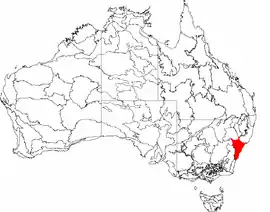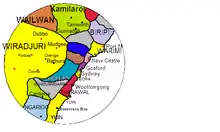Awabakal
The Awabakal people /əˈwɒbəɡæl/, are those Aboriginal Australians who identify with or are descended from the Awabakal tribe and its clans, Indigenous to the coastal area of what is now known as the Mid North Coast region of New South Wales. Their traditional territory spread from Wollombi in the south, to the Lower Hunter River near Newcastle and Lake Macquarie in the north.
| Awabakal people | |
|---|---|
| aka: Awabagal, Awaba, Kuri, Minyowa, Minyowie [1] | |
 Mid North Coast bioregion | |
| Hierarchy | |
| Language family: | Pama–Nyungan[2] |
| Language branch: | Yuin–Kuric |
| Language group: | Kuri |
| Group dialects: | Awabakal |
| Area (approx. 1,800 sq. km) | |
| Bioregion: | Mid North Coast |
| Location: | Mid North Coast, New South Wales |
| Coordinates: | 33°5′S 151°30′E[1] |
| Other geological: | Lake Macquarie[1] |
| Notable individuals | |
| Biraban | |
The name Kuringgai, also written Guringai, has often been used as a collective denominator of the Awabakal and several other tribes in this belt, but Norman Tindale has challenged it as an arbitrary coinage devised by ethnologist John Fraser in 1892. For Tindale, Kuringgai was synonymous with Awabakal.[1] Arthur Capell however asserted that there was indeed evidence for a distinct Kuringgai language, which, in Tindale's schema, would imply they were a distinct people from the Awabakal.[3]
Name
In their language, awaba was the word for Lake Macquarie, meaning flat or plain surface, and by extension referred to the people native to that area. The Awabakal were bounded to the north–west by the Wonnarua, the Worimi to the north–east, and the Darkinung peoples to the west and south. Awaba is now the name of a small town in the region.
Language

Awabakal language was recorded by Lancelot Edward Threlkeld and Awabakal Leader Birabahn in 'An Australian grammar : comprehending the principles and natural rules of the language as spoken by the Aborigines in the vicinity of Hunter's River, Lake MacQuarie & New South Wales' -'and this is the first, and most comprehensive record of any indigenous language in Australia.
Country
Tindale estimated Awabakal territory to cover some 700 square miles (1,800 km2).[1] More recent estimates are that Awabakal territory covers 2870 square kilometres.
Practices
The eaglehawk or wedge-tailed eagle has special significance for the Awabakal people. Kon, their "celestial entity", looks like an Aboriginal man, but in flight resembles an eagle-hawk.[4][5]
The Awabakal people played a significant part in shaping the environment of their region. They practised fire-stick farming extensively, which helped them to hunt and to navigate through dense prickly scrub along the coast.[5] Newcastle's main city thoroughfare, Watt Street was built over an Awabakal path from the shore to the top of a hill.[6] Fishing, particularly for shellfish, was a significant part of the Awabakal people's diet and culture pre-colonisation.[5]
The Awabakal, in pre-colonisation times, were noted as being strong and determined defenders of their territory, the means by which the defence occurred need to be explored to deepen understanding of the culture. They had possession of their rich coastal territory for thousands of years, during which time they successfully repelled incursions by the neighbouring Gamilaraay people and established places of defence, "virtual armouries", high in the Watagan Mountains.[5]
Today
Descendants of the traditional owners, that is, descendants of those Awabakal forebears who survived the British invasion/colonisation massacres, especially during the land grab of 1826, are direct descendants of Margaret and Ned or Mahrahkah. These descendants are connected through their families/family culture together and represented by the Awabakal Descendants of the Traditional Owners Aboriginal Corporation.
These people, the traditional owners of the Awabakal region have lived on, loved and looked after the magnificent Awabakal land and water systems continuously for millennia, at least since the last Ice Age, 11,800 years ago.
Their extraordinary resilience, is in part due to their excellence in civic relations, as demonstrated by their forebear, the most important Indigenous Intellectual of Australia in C19th, Birabahn and this is seen in their consideration of newly settled Aboriginal people on Awabakal lands and water places.
Recently settled aboriginal people in this region partake in community support organisations like 'The Awabakal Newcastle Aboriginal Cooperative Limited', which is a not-for-profit community controlled organisation operating in the Newcastle, Lake Macquarie and Hunter Region. It was established in 1976. It is responsible for the delivery of community and health services to Aboriginal people in this region, including:
- the Awabakal Medical Centre;
- the Awabakal Disability Service which provides "short to medium term support to young people living with a disability";
- culturally appropriate care for older people;
- and child care services.[7]
Centres
The Awabakal Environmental Education Centre began operating in 1976. It is an NSW Department of Education and Communities facility. The centre provides opportunities for teachers and students in the Hunter Region to learn about the environment and human interactions with the natural world.[8] Wollotuka, meaning an 'eating and meeting place' originally began as a support programme in 1983 to assist and promote university studies for indigenous people. Wollotuka's all indigenous staff moved into their new building, Birabahn in 2002, and the Wollotuka Institute was officially established in 2009.[9][10]
Native title
In 2013 an association of Awabakal and Guringai descendants laid claim to native title over land from Maitland to Hornsby.[11] The claim was opposed by representatives of the Worimi and Wonnarua as asserting rights over their own traditional territories.[12] In 2017 the claim was withdrawn after the NSW government claimed that, while the claim group, the Descendants of the Traditional Owners Aboriginal Corporation had shown descent from the original people indigenous to the area, it was argued that they had failed to demonstrate continuous preservation of customary laws and practices since the onset of white colonization. [13]
Notable Awabakal people
- Biraban – a recognised headman of the Awaba clan[5] who assisted the Rev Lancelot Threlkeld compile the first grammar of an Aboriginal language in Australia.[14]
Alternative names
- Awaba (Awabakal toponym designating Lake Macquarie)
- Awabagal
- Kuri (generic term ("man") in Sydney area languages).
- Kuringgai
- "Lake Macquarie, Newcastle" tribe
- Minyowa (Awabakal horde at Newcastle)
- Minyowie
Source: Tindale 1974, p. 191
Notes
Citations
- Tindale 1974, p. 191.
- Lissarrague 2006.
- Attenbrow 2010, p. 33.
- Threlkeld 1974, pp. 3,5,66.
- Maynard 2014, p. ?.
- Duncan 2013.
- Awabakal.
- AwabakalEEC.
- Wollotuka1.
- Wollotuka2.
- Kelly 2013.
- Connor 2016, p. 111.
- Fellner 2017.
- Van Toorn 2006, p. 43.
Sources
- "About Us". Awabakal.org. Archived from the original on 19 July 2012.
- "AIATSIS map of Indigenous Australia". AIATSIS.
- Attenbrow, Val (2010). Sydney's Aboriginal Past: Investigating the Archaeological and Historical Records. University of New South Wales Press. ISBN 978-1-742-23116-7.CS1 maint: ref=harv (link)
- "Awabakal EEC". Awabakal Environmental Education Centre. Archived from the original on 16 February 2014.
- Connor, Linda H. (2016). Climate Change and Anthropos: Planet, People and Places. Routledge. ISBN 978-1-317-97055-2.CS1 maint: ref=harv (link)
- Dixon, Robert M. W. (2002). Australian Languages: Their Nature and Development. Volume 1. Cambridge University Press. ISBN 978-0-521-47378-1.CS1 maint: ref=harv (link)
- Duncan, Carol (29 May 2013). "Newcastle's first street to be illuminated". ABC Newcastle.CS1 maint: ref=harv (link)
- Fellner, Carrie (11 October 2017). "Awabakal and Guringai native title claim from Maitland to Hornsby put on ice". The Newcastle Herald.CS1 maint: ref=harv (link)
- Grimes, Barbara (2003). "Worimi Languages". In Frawley, William (ed.). International Encyclopedia of Linguistics: AAVE-Esperanto. Volume 1. Oxford University Press. p. 378. ISBN 978-0-195-13977-8.CS1 maint: ref=harv (link)
- "History of Wollotuka". University of Newcastle.
- Kelly, Matthew (9 October 2013). "Awabakal land claim lodged". The Newcastle Herald.CS1 maint: ref=harv (link)
- Lissarrague, Amanda (2006). A salvage grammar and wordlist of the language from the Hunter River and Lake Macquarie (PDF). Muurrbay Aboriginal Language and Culture Cooperative. ISBN 0-9775351-0-X.CS1 maint: ref=harv (link)
- Mathews, R. H. (1897). "Keepara ceremony of initiation". The Journal of the Anthropological Institute of Great Britain and Ireland. 26: 320–340. JSTOR 2842007.CS1 maint: ref=harv (link)
- Maynard, John (2014). "Callaghan, The University of Newcastle: Whose Traditional Land?" (PDF). The Wollotuka Institute, University of Newcastle.CS1 maint: ref=harv (link)
- Skuttnabb-Kangas, Tove (2003). "Linguistic Diversity and Biodiversity: The Threat from Killer Languages". In Mair, Christian (ed.). The Politics of English as a World Language: New Horizons in Postcolonial Cultural Studies. Rodopi Publishers. pp. 31–52. ISBN 978-9-042-00876-2.CS1 maint: ref=harv (link)
- Threlkeld, Lancelot Edward (1974). Gunson, Niel (ed.). Australian reminiscences & papers of L. E. Threlkeld, missionary to the Aborigines, 1824-1859. 40, Part 1. Australian Institute of Aboriginal Studies.CS1 maint: ref=harv (link)
- Tindale, Norman Barnett (1974). "Awabakal (NSW)". Aboriginal Tribes of Australia: Their Terrain, Environmental Controls, Distribution, Limits, and Proper Names. Australian National University.CS1 maint: ref=harv (link)
- Van Toorn, Penny (2006). Writing Never Arrives Naked: Early Aboriginal Cultures of Writing in Australia. Aboriginal Studies Press. ISBN 978-0-855-75544-7.CS1 maint: ref=harv (link)
- "Wollotuka Institute". University of Newcastle.